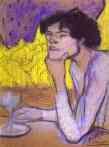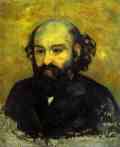Olga's Gallery
Dear Friends of Art,
Today we continue the topic started in the letter dated June 1, 2001. The Hermitage exhibition of 1995 presented the works of famous artists, formerly unknown or presumed to be destroyed.
Hidden Treasures
The
re-discovered treasures from the Hermitage didn't only reveal the unknown
masterpieces of famous artists, but also the names of the collectors. One
of them is Josef Karl Paul Otto Krebs. Almost all of his collection is
in the Hermitage now.
Otto Krebs was born in 1873, in Wiesbaden, and died in 1941, childless.
He graduated from a university with the degree of Doctor of Philosophy,
and very soon showed himself as a gifted businessman on the post of controlling
officer at Strebel’s factory. In his estate, Holzdorf, he gathered many
items of art starting with ancient furniture to contemporary paintings.
In the 1920s, when the factory brought especially high incomes, Krebs bought
the paintings of the Impressionists. Unlike the American collector Dr.
Barns from Philadelphia, who used to buy everything he could get, Dr. Krebs
was very selective. He did not need the amount, he needed only the quality.
As a result there are no ordinary works in his collection, all of them
are masterpieces. Otto Krebs chose the paintings that reflected all sides
of a painter's talent. The core of his collection is made up of works by
Cézanne,
Van
Gogh, and Gauguin.
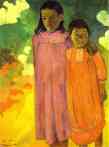 There
are only 4 Gauguin paintings in his collection, but the works are very
interesting: two early still-lifes At
the Window, and Bouquet,
the latter with its dramatic effect precursors the artist's future symbolic
pictures. The most typical of Gauguin’s is Taperaa
Mahana (Late Afternoon). It has everything one can expect from
a picture of the Tahiti period: a narration about the islanders’ life,
bright and exotic colors and a specific rhythm. But maybe the best in Krebs’s
collection is Piti Teina (Two Sisters),
the canvas, which miraculously unites monumentality and solemnity with
delicacy and the charm of childhood.
There
are only 4 Gauguin paintings in his collection, but the works are very
interesting: two early still-lifes At
the Window, and Bouquet,
the latter with its dramatic effect precursors the artist's future symbolic
pictures. The most typical of Gauguin’s is Taperaa
Mahana (Late Afternoon). It has everything one can expect from
a picture of the Tahiti period: a narration about the islanders’ life,
bright and exotic colors and a specific rhythm. But maybe the best in Krebs’s
collection is Piti Teina (Two Sisters),
the canvas, which miraculously unites monumentality and solemnity with
delicacy and the charm of childhood.
Krebs’ selection of Cézanne and Van Gogh’s works also deserves your attention.
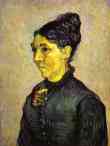 Vincent
Van Gogh. Portrait of Mme Trabuc.
Vincent
Van Gogh. Portrait of Mme Trabuc.
Van Gogh executed the portrait of Mme Jeanne Lafuie Trabuc shortly after
that of her husband's, Charles-Elzear Trabuc, who was the chief overseer
at the Saint Paul de Mazolle hospital in Saint Remi. Mme Trabuc was fifty-five
when she sat for Van Gogh. In one of his letters to his brother Theodore,
Van Gogh wrote: “I finished the portrait of the overseer… I gave
him the portrait as a gift and I'm going to paint the portrait of his wife,
if she agrees to sit for me. She is a meek, faded and unhappy woman, so
piteous and unremarkable that I would dearly like to depict on a canvas
this bleak grass stalk… She assures me that I am perfectly sane.”
Without a doubt this painting from Otto Krebs’s collection is the one
of the best works of the young Picasso. It is linked with two other paintings,
executed in Paris in 1901: The
Absinth Drinker and The
Absinth Drinker. Comparing the three versions of the
topic you can see that the women in them are different, and knowing that
Picasso usually painted from life, we can safely propose that there were
several models, but who were they?
This self- portrait of Cézanne occupies a special place among his other self-portraits, which number more than twenty. It is remarkable in that Cézanne didn't use a mirror but copied his own portrait by Renoir, which had been commissioned by Victor Chocquet. In creating his own version, Cézanne used pastel, like the original. While maintaining the size and proportions of Renoir’s work, Cézanne gave himself a sharper and harsher look. Cézanne gave the painting to Camille Pissaro as a gift, who had a small collection of Cézanne’s self-portraits.
Works by Camille Pissaro and
Alfred
Sisley from the Krebs collection can be found marked ‘NEW’ in the artists’
sections.
We have also added some new sections to the gallery:
Mikhail Lebedev (1811-1837),
a Russian landscape painter of the early 19th century;
Count Feodor Tolstoy (1783-1873),
a Russian artist of the same period.
And the section of the wonderful painter of the 20th century, Henri
Matisse, is added. In the collection of about 160 works by Matisse
there is also one painting from the Otto Krebs collection The
Ballet Dancer.
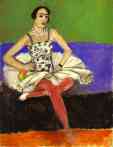 Henri
Matisse. The Ballet Dancer.
Henri
Matisse. The Ballet Dancer.
In 1920, Matisse met a 19-year-old girl who became his model for
the next seven years and whose help influenced the mood of many paintings
of the Nice period. That girl was Arriette Darricarrere, who learned ballet
in the Victoria Studio. Matisse’s interest to ballet arose after the WWI
thanks to his contacts with Diaghilev’s Russian Ballet Company. In 1919,
he executed a stage set and costume designs for the company’s ballet “The
Nightingales Songs”, music by Igor Stravinsky.
The Darricarrere family lived in Nice not far from Matisse’s workshop.
Artistic Arriette was an ideal model, she could quickly change into an
eastern odalisque, into a passionate Spanish girl, into a musician, or
into a ballet dancer. We have two portraits of Arriette as a ballet dancer,
one is from Otto Krebs’ collection. The other one is The
Ballet Dancer, Harmony in Grey, now in a private collection.
In 1928, Arriette’s marriage brought an end to the posing sessions.
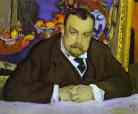 One of Matisse’s admirers and a collector of his works in Russia was Ivan
Morozov, a manufacturer. The Russian artist, Valentin
Serov, whom Morozov also admired, on the contrary did not like the
post-impressionist tendencies in painting. While executing his portrait
of Ivan Morozov, Serov on purpose chose the ‘flat decorative style and
colors’ of Matisse. In the background is the latter’s Still-life from Morozov’s
collection. Serov wanted to show Morozov how more primitive portraits look
fulfilled in this modern style. To the artist's surprise Morozov liked
his portrait. The artist would have been even more surprised if he knew
that present viewers like it too!
One of Matisse’s admirers and a collector of his works in Russia was Ivan
Morozov, a manufacturer. The Russian artist, Valentin
Serov, whom Morozov also admired, on the contrary did not like the
post-impressionist tendencies in painting. While executing his portrait
of Ivan Morozov, Serov on purpose chose the ‘flat decorative style and
colors’ of Matisse. In the background is the latter’s Still-life from Morozov’s
collection. Serov wanted to show Morozov how more primitive portraits look
fulfilled in this modern style. To the artist's surprise Morozov liked
his portrait. The artist would have been even more surprised if he knew
that present viewers like it too!
<
